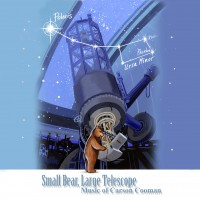Opus 652
Pittsburgh Concerto (2005)
for Orchestra
3(picc).2+Eh.3+Bcl.2+Cbn/4.3.3.1/3perc.timp/pno/strings
Carnegie Mellon Philharmonic; Efraín Amaya, conductor
Duration: 10 min.
Dedication: for Amy Stabenow
Commission: Commissioned by the Carnegie Mellon School of Music
 Recorded on Small Bear, Large Telescope: Music of Carson Cooman (2006)
Recorded on Small Bear, Large Telescope: Music of Carson Cooman (2006)Publisher: Musik Fabrik
Performance materials available from the publisher.
Pittsburgh Concerto (2005) was written for the Carnegie Mellon Philharmonic and is dedicated to Amy Stabenow, concert manager at Carnegie Mellon’s School of Music. The piece was conceived as a tribute to the city of Pittsburgh, Pennsylvania, USA.
The work contains only two specific “programmatically inspired” images related to Pittsburgh. They form the outer two sections of the work. The inner four sections are inspired more abstractly by various aspects of the city, its landscapes, and its people; they feature a series of solos and duets for many members of the orchestra—in the manner of a “concerto for orchestra.”
The opening of the work is inspired by Pittsburgh’s history as America’s steel capital. Colors and sounds of the clangorous industrial age of America’s past are evoked. The basic musical material (a six-note cell) for the entire work is presented in this aggressive introduction. Throughout the rest of the work, this basic material is developed in ways that range from lushly romantic to aggressively athletic.
The following section is marked “slow, lush” and features a duet first between trumpet and tuba, over warm harmonies in the orchestra. A brief duet for vibraphone and marimba leads to an extended viola solo.
The next section is fast and energetic. It begins with an athletic duet for English horn and bass trombone, followed by a ringing duet of tubular bells and crotales. The final solo is for violin, as the orchestral texture disintegrates around it.
The next section, marked “slow, mystical”, begins with a duet between piano and bass clarinet. A passionate horn duo follows before a passage for solo bass leads directly into the next section.
This section is fragmentary and halting. An unpitched duo of bass drum and flexatone begins, leading to an aggressive and abortive duet between solo flute and bassoon. Finally, an extended cello solo closes the section.
The final part of the work is inspired by my first visit to Pittsburgh. When driving in from Pittsburgh airport (which is far outside the city), the city itself is “hidden” from the road by hills. Upon reaching the hills, one enters the Fort Pitt tunnel and, after a few moments, emerges from it on a suspension bridge over the Monongahela River. Late at night, this was a truly breathtaking moment as the city and its rivers emerged suddenly in a mass of glittering lights. The ecstatic rush of the lighted city at night is portrayed in this section—amidst fragments from the opening, recalling the industrial past, now transformed into something new.
